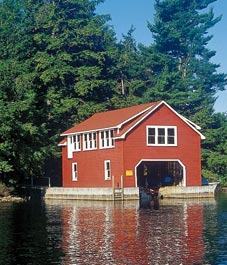Build a better boathouse
Consider your impact on the shoreline when you build a nautical garage
A boathouse and dock can also be built on pilings. Years ago, wood pilings were used, often with several driven tightly together and bound with ropes or cable. Thick-walled steel tubes are used now. These can be pushed or driven deep into softer bottoms. By using hardened points, they can be driven into gravel and even an overburden of jumbled rock. Marine contractors weld a framework of steel cross-members to the pilings, as stringers for the decking of a dock and the skeleton of a boathouse. As with any dock, the initial construction is fairly invasive, but the footprint of the pilings is relatively small compared to cribs.
At a single dock parallel to shore, there may be an application for an awning cantilevered out over the water to provide shade and shelter for a boat. Such structures are effective if there isn’t exposure to high winds. Another alternative is a boat port: a floating, roofed structure without walls, for summer shelter only.
Whatever the type of structure, building small is practical, but don’t underbuild. With an in-water structure, both the building and ecological costs are high, and costs are not likely to diminish when the inevitable replacement is needed. Strength comes from design and also the materials. Triple-galvanized hardware, big bolts and washers, heavy specialty hinges on ramps, heavy-duty hangers and corner reinforcements–all are available at lumber retailers in cottage country. Look at other boathouses on your waterfront to note where they’ve both succeeded and where they failed, and learn by example.
 Ice will always be a concern with any type of structure, especially as it melts and moves during the spring thaw. Shifting ice can move or tip boathouse cribs. With rising water levels, ice can lift pilings or push up structures up from under the staving. Structures on exposed shorelines are especially vulnerable. Ice can add extra weight to floating boathouses, as it tends to build up onto and seemingly climb the floats and may tilt the structure.
Ice will always be a concern with any type of structure, especially as it melts and moves during the spring thaw. Shifting ice can move or tip boathouse cribs. With rising water levels, ice can lift pilings or push up structures up from under the staving. Structures on exposed shorelines are especially vulnerable. Ice can add extra weight to floating boathouses, as it tends to build up onto and seemingly climb the floats and may tilt the structure.
Manage the shoreline
When deciding what type of structure to build–or whether to build at all–get to know the character and nature of your shoreline, in all seasons of the year. See what a structure would look like from your neighbour’s view. Study the long-term trends and predictions for your lake or river: where will your water levels be, given water use and climate change, in the decades to come? You need to discover how to have the lowest possible impact on the environment and shoreline.
As real estate agents say, in justification of the high price of waterfront property, “they’re not making any more of it.” Waterfront is precious. Municipal councils, rural and urban alike, face contentious issues of access, water quality, development and redevelopment, conservation, scenic qualities, tax base and much more. Jurisdiction is multiple, layered and overlapping.
Jump to a section
- Page 1 : Getting started
- Page 2 : Building with cribs
- Page 3 : Building on pilings; Managing the shoreline
- Page 4 : Low-impact designing and proper planning
- Page 5 : Rules and regulations for boathouse building
To leave a comment, please log in











No comments